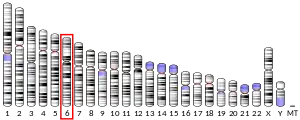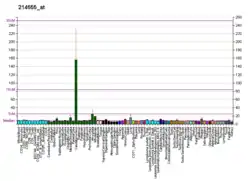GPR6
G protein-coupled receptor 6, also known as GPR6, is a protein which in humans is encoded by the GPR6 gene.[5][6]
Function
GPR6 is a member of the G protein-coupled receptor family of transmembrane receptors. It has been reported that GPR6 is both constitutively active but in addition is further activated by sphingosine-1-phosphate.[7]
GPR6 up-regulates cyclic AMP levels and promotes neurite outgrowth.[8]
See also
References
- GRCh38: Ensembl release 89: ENSG00000146360 - Ensembl, May 2017
- GRCm38: Ensembl release 89: ENSMUSG00000046922 - Ensembl, May 2017
- "Human PubMed Reference:". National Center for Biotechnology Information, U.S. National Library of Medicine.
- "Mouse PubMed Reference:". National Center for Biotechnology Information, U.S. National Library of Medicine.
- "Entrez Gene: GPR6 G protein-coupled receptor 6".
- Song ZH, Modi W, Bonner TI (July 1995). "Molecular cloning and chromosomal localization of human genes encoding three closely related G protein-coupled receptors". Genomics. 28 (2): 347–9. doi:10.1006/geno.1995.1154. PMID 8530049.
- Uhlenbrock K, Gassenhuber H, Kostenis E (November 2002). "Sphingosine 1-phosphate is a ligand of the human gpr3, gpr6 and gpr12 family of constitutively active G protein-coupled receptors". Cellular Signalling. 14 (11): 941–53. doi:10.1016/S0898-6568(02)00041-4. PMID 12220620.
- Tanaka S, Ishii K, Kasai K, Yoon SO, Saeki Y (April 2007). "Neural expression of G protein-coupled receptors GPR3, GPR6, and GPR12 up-regulates cyclic AMP levels and promotes neurite outgrowth". The Journal of Biological Chemistry. 282 (14): 10506–15. doi:10.1074/jbc.M700911200. PMID 17284443.
Further reading
- Heiber M, Docherty JM, Shah G, et al. (1995). "Isolation of three novel human genes encoding G protein-coupled receptors". DNA Cell Biol. 14 (1): 25–35. doi:10.1089/dna.1995.14.25. PMID 7832990.
- Song ZH, Modi W, Bonner TI (1996). "Molecular cloning and chromosomal localization of human genes encoding three closely related G protein-coupled receptors". Genomics. 28 (2): 347–9. doi:10.1006/geno.1995.1154. PMID 8530049.
- Strausberg RL, Feingold EA, Grouse LH, et al. (2003). "Generation and initial analysis of more than 15,000 full-length human and mouse cDNA sequences". Proc. Natl. Acad. Sci. U.S.A. 99 (26): 16899–903. doi:10.1073/pnas.242603899. PMC 139241. PMID 12477932.
- Uhlenbrock K, Huber J, Ardati A, et al. (2003). "Fluid shear stress differentially regulates gpr3, gpr6, and gpr12 expression in human umbilical vein endothelial cells". Cell. Physiol. Biochem. 13 (2): 75–84. doi:10.1159/000070251. PMID 12649592. S2CID 45156405.
- Mungall AJ, Palmer SA, Sims SK, et al. (2003). "The DNA sequence and analysis of human chromosome 6". Nature. 425 (6960): 805–11. doi:10.1038/nature02055. PMID 14574404.
- Gerhard DS, Wagner L, Feingold EA, et al. (2004). "The Status, Quality, and Expansion of the NIH Full-Length cDNA Project: The Mammalian Gene Collection (MGC)". Genome Res. 14 (10B): 2121–7. doi:10.1101/gr.2596504. PMC 528928. PMID 15489334.
External links
- "GPR6". IUPHAR Database of Receptors and Ion Channels. International Union of Basic and Clinical Pharmacology.
This article is issued from Wikipedia. The text is licensed under Creative Commons - Attribution - Sharealike. Additional terms may apply for the media files.




